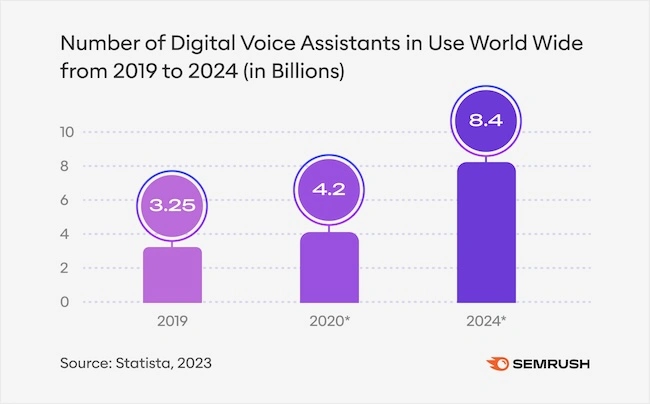SEO Trends in 2024: Tips to Stay Ahead of Competitors

In the ever-changing search engine optimization (SEO) landscape, businesses must stay current with SEO trends and core algorithm updates to not fall behind their competitors.
Staying on top of SEO trends while being nimble within the digital landscape is the best recipe for the organic success of your website. Neglecting to do so can result in serious organic traffic loss and keyword position drops. Considering organic traffic typically results in higher engagement, CTR, and conversions than other channels, ignoring SEO trends could cost your business a lot of money.
Where do SEO trends come from?
Google is constantly updating its algorithm to achieve the ultimate goal of providing users with the best content available to answer their search queries. In fact, Google makes minor adjustments to its core algorithm once or twice a day – that's roughly 500-600 times a year!
But before you panic, those daily algorithm updates are usually so minor that there’s no noticeable or measurable impact. It’s the major core algorithm updates, which happen on average once or twice a year, that need to stay on your radar. Google’s major core algorithm updates help us understand SEO trends to be aware of and optimize for, allowing us to align our content with Google's ranking factors.
But why does SEO matter?
Your company could have the most beautiful, functional website on the planet. But if your website isn’t making use of Search Engine Optimization (SEO), you’re likely missing out on organic traffic and revenue.
The benefits of having SEO incorporated into your digital marketing strategy include:
- Improve search rankings
- Boost online authority and credibility
- Gain organic website traffic
- Enhance user experience
- Gain a competitive advantage over competitors
Optimize for These SEO Trends in 2024
Knowing that SEO trends come directly from Google’s continual strides to provide the best, most helpful content to users from an expert, trusted, authoritative source, being aware of the specifics of core updates – and ultimately understanding SEO trends – is crucial for organic success.
So let’s take a look at SEO trends for 2024 and how to capitalize on them.
Trend #1: Voice Search Optimization
Did you know that voice assistants are expected to reach 8.4 billion units this year alone? That’s roughly 400 million more voice assistants than people in the world! Whether you’re asking Alexa or Google a question or vocalizing directly to your smartwatch or smartphone, the evolution of voice search is upon us – and from the looks of it, it’s not going away.

Optimizing for voice search essentially means optimizing for longtail keywords, which are naturally more conversational in nature. A longtail keyword is a phrase using three words or more.
For example, "what is a longtail keyword" is a longtail keyword. People use voice search to ask questions, so finding longtail keywords using “who”, “what”, “where”, “when”, and “how” is a great place to start.
When you start to write content to answer longtail question keywords, make sure you include a brief answer right at the top of the page. This is a tried-and-true SEO strategy to attempt to gain the zero position in search, aka the “featured snippet”, but it also works incredibly well for voice search.
Because let’s face it. No one wants Alexa reading them a 1500-word blog. They’re looking for a quick, direct answer to their question. So that’s what you need to give them right off the bat to optimize for voice search.
Trend #2: AI and Machine Learning in SEO
Search engines have been using AI (artificial intelligence) technology for years now but it hasn’t been until recently that people can use GPT (generative pre-trained transformer) tools to help with some basic SEO tasks, like keyword research and creating content outlines.
Starting last year and moving into this year, we’re seeing two major changes to organic search thanks to AI.
First, AI is being used to find and understand websites and content that is truly helpful to users, not just those that have been optimized for SEO. When optimizing any content, it’s important to take a user-first approach, as AI is also taking this approach. Websites that just have keywords stuffed into them without providing any new information will not rank well, because they’re simply not helpful to users.
In 2023, we saw the introduction of Search Generative Experience (SGE), which was only available to users (like myself) who signed up for beta testing on Google Labs. During that time, I was able to understand a little more about how SGE might impact organic search. On May 14, 2024, Google’s SGE was rolled out to all users in the United States.
Now that SGE has rolled out to all users, the true impact of SGE will become apparent and quantifiable over the next few months.
A Brief Use Case on SGE
There's been a lot of talk in the SEO and search world about how generative AI is going to take away organic traffic.
As I mentioned above, I have been beta testing Google’s SGE since 2023, which let me do some testing on the possible impact on organic traffic. So let’s dive in!
My query was "how do I disconnect a hot water heater", because I know a blog that I wrote years ago still appears in the top 3 results for this query.
Do you see how Google generated the steps, but still provided links to the top three organic results on the search engine results page (SERP)?

First of all, we have to ask ourselves if users can get everything they need just from the numbered list with the steps. If they are Googling how to do this, it's likely they need a little more support, whether it be video or pictures.
Since Google is showing three of the top listings right there in the AI-generated answer — which Google does plan on showing in the "zero" spot but has historically been reserved for a featured snippet — it essentially allows three pieces of content to share the "zero" spot.
I noticed that the number one organic result and featured snippet – my blog – was listed first, and that SGE utilized a version of the “how to” steps that I included.
Next, I looked at the numbered list provided by generative -AI vs. the numbered list my blog included as a table of contents (TOC). I created this TOC, with anchor links for each step, to help increase organic ranking.

The bottom line is that the list Google provided is very close to the list I created, which, by the way, also uses structured data (HowTo schema markup), making it easier for machines to understand. However, HowTo schema markup was deprecated in September 14, 2023. Although HowTo schema no longer shows rich results in SERPs, it might still have a functional benefit in helping machines understand data. 
Now, no one can say for sure, but it appears that AI might have used the structured data on my blog as a building block, and then rewrote some steps to be more conversational, as AI does.
So let's ask ourselves — is generative AI in search really a threat, or can we use it to our advantage to essentially get a featured snippet by ensuring our content is well optimized, allowing it to appear in the generative AI results above the fold? Seems like it's even more reason to optimize as much as possible.
SEO is all about making your website awesome for visitors. By using AI tools and keeping up with how search engines work, you can make your website stand out and get found by the people who matter most.
Trend #3: E-E-A-T and Content Quality
E-E-A-T stands for “Experience, Expertise, Authoritativeness, and Trustworthiness”, and although it’s not part of Google’s core algorithm, it directly impacts the ability for content to rank well in search results.
After releasing their Search Quality Rating Guidelines in March 2013, Google added the concept of E-A-T (Expertise, Authoritativeness, Trustworthiness) to those guidelines in 2014.
Google has a gigantic team of Search Quality Raters – 16,000 of them, to be exact. These are real people whose job is to manually visit websites and rate them based on Google’s Search Quality Rater Guidelines, a massive 167-page document.
Almost 10 years later, in December 2022, Google added an additional “E” for “Experience”, meaning Google values content written from first-hand experience.
It should be clear by now that Google’s emphasis on, and favoring of, strong, authoritative, trustworthy content isn’t going anywhere. In fact, core algorithm updates are almost always slated to improve the results shown in search results based explicitly on E-E-A-T. This isn’t going away, and failure to align with best practices to capitalize on E-E-A-T is not only a missed opportunity, but also a huge mistake that is likely to cost you valuable traffic-driving positions.
So, if you don’t think that E-E-A-T should be a priority for your website, think again. E-E-A-T becomes even more important if your business publishes “Your Money, Your Life” (YMYL) content, which refers to “content that could impact a person’s financial stability, health, safety, or well-being". Due to these potential impacts, Google considers YMYL content more important and actually holds it to a higher quality (E-E-A-T) standard.
How to Optimize for E-E-A-T
Every good content strategy should include optimizing for E-E-A-T.
Let’s start by looking at the first E for “experience”. A SME’s experience should be reflected within the content itself. When experience is included in content, it not only personalizes and humanizes it, it also builds trust with your readers and showcases your authority.
Optimizing for the last three letters of the acronym becomes slightly more technical, since this is best done through bylines and author pages. However, other techniques that shouldn’t be overlooked are citing reputable sources within your content, and publishing content that has been well-researched.
Bylines should include a paragraph that speaks to why the author is qualified to write the content, and should include their name, professional title, the number of years of experience in their industry, education, any important certifications or awards that showcase them as a thought-leader.
If you want to take it to the next level, creating dedicated author pages is a perfect SEO enhancement. Where the byline briefly tells the reader about the author of the article they’re currently reading, author pages house links to all of the articles that author has written.
Author pages help establish website authority and expertise, which helps increase website visibility in search results. Plus, author page URLs can be added to your article’s schema markup, providing Google with an even more meaningful signal by way of structured data.
Trend #4: Visual Search Optimization
You’ve probably heard this before, but in search, “content is king”. And content isn’t just limited to articles but includes images, too!
As of April this year, there have been over 12 billion monthly searches on Google Lens alone. That number alone should indicate the importance of optimizing your images for visual search.
There are several tactics for optimizing images, including:
- Use Descriptive File Names: This is optimization at the local level. Before you ever upload an image to your website or CDN, you should make sure that the file name isn’t just a string of random characters, letters and numbers. Name your files using keywords to have the most impact. Use lowercase letters and dashes. (image_1239=&2q847329874u.webp vs. seo-trends-visual-search.webp).
- Add Alt Text: Alt text, also known as alternative text, is a description of your image in words for visually impaired people using screen readers. But alt text also has SEO weight. To optimize your alt text, use keywords where possible and describe your image in 125 characters or less (100 characters is ideal). Don’t include “Image of” since screen readers include this naturally when reading alt text aloud.
- Create a Dedicated Image Sitemap: If your website is large and contains many images, you might need an image sitemap.xml. Since XML sitemaps can only contain 50k URLs, it’s often best to create a sitemap specifically for your images, especially if you want them indexed in visual search.
You can also add ImageObject schema markup to your images using schema.org.
Trend #5: Video Content and SEO
Google is moving toward a more visual search, which includes videos being given higher positions for certain queries than articles. In February of this year, Google started referring to video searches as “video mode”. And according to a recent article from OnTheMap.com, 13.8% of searchers preferred video results, making this an SEO trend to watch.
To ensure your videos can be found in organic search or as a video snippet, your videos need to be embedded high up on your page (above the fold). This will allow them to appear within the First Contentful Paint, or the “initial load” of your page.
You should also markup your videos using VideoObject schema markup. Most importantly, your schema markup should include:
- Video title
- Video player or encapsulated media file
- Video description
- Video thumbnail
- Video duration
If your videos are hosted on YouTube or another popular video platform, make use of keywords in your title, description and tags. You can actually use Google Trends to find popular video-specific queries to help drive organic traffic!
Need Help Optimizing for 2024 SEO Trends?
The expert SEO team at Sagepath Reply can help! From keyword research and SEO audits to product optimization and more, our team can help boost the organic visibility of your business’s website while aligning with your business goals, target audience, and KPIs.
Additional Sources:
About The Author:
Dylan Goldman, Sr. SEO & GEO Manager | Sagepath Reply
Dylan is a search engine optimization (SEO), content strategist and copywriter with over 15 years of experience helping enterprise brands increase their organic visibility and drive measurable growth. Working with Fortune 500 and 1000 companies, he specializes in keyword research and optimization, technical SEO, schema markup, and high-level content strategy. Dylan is also leading initiatives in Generative Engine Optimization (GEO), helping organizations prepare their content for AI-driven search experiences and emerging answer engines.

Let’s Start a Conversation
Reach out to discuss your digital transformation needs and see how we can help. We would love to start a long-term partnership with your company.
Get in Touch


